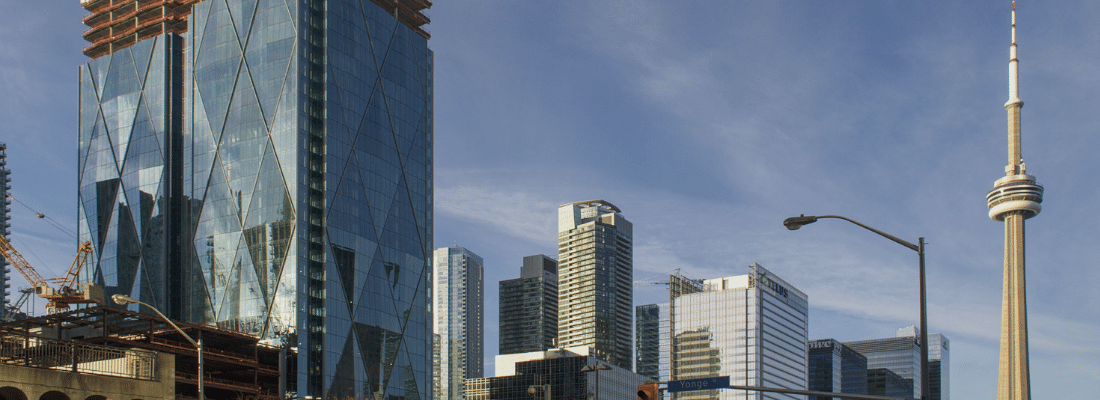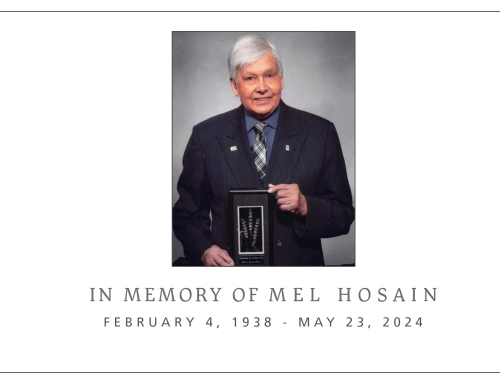Nothing is standard about this project meant to change everything about office buildings
By Derek Howchin, Senior Project Manager, Walters Group and Jessica Ranalli, Project Manager, Walters Group
Head down the Gardiner Expressway in Toronto and you can’t miss the towering structure next to Scotiabank Arena: CIBC SQUARE.
It’s the most advanced tower ever constructed in Canada, and likely all of North America. It has been planned for more than seven years, with construction challenges that rival anything previously built in Canada. Yet the tower is just one part of this extremely complex project, which also includes a pedestrian bridge to the neighbouring arena and a one-acre park being built over the second-busiest railway station in North America. Added to all this is a second tower, which will begin construction this summer.
The first tower, 81 Bay Street, is currently under construction, and will have 49 occupied stories upon completion this fall. Its twin will be 141 Bay Street (site of the current GO bus terminal) which will consist of 50 occupied stories, scheduled for occupation in 2024. Together, the towers will add three million square feet of space to downtown Toronto.
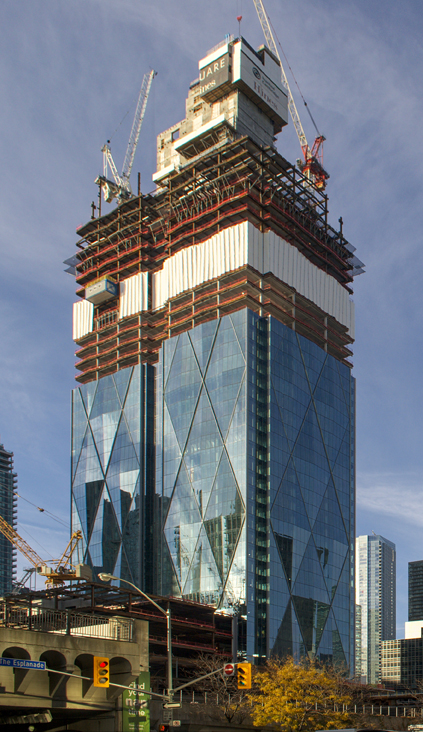
Getting With the Plan
Real estate firms Ivanhoé Cambridge and Hines began work on the project over 10 years ago with architect Adamson Associates, resulting in a stunning design built to meet several criteria: efficient use of space, speed of construction, design-forward features, connections to transportation and innovations in environmental sustainability.
“We chose a hybrid structure with a concrete core and structural steel, primarily for speed,” says John Frank, Senior Vice President (Construction) for Hines. “With steel, a building can be completed six to eight months faster.”
It was in April of 2017 that CIBC chose the building to be the home of their new Canadian head office. In that same timeframe, Canadian steel icon Walters Group Inc. was brought on to work with EllisDon, the general contractor. “Walters was able to provide the engineering expertise and best practices, and assist us with the design, as we knew it would evolve over the course of this project,” says Andrea Quadrini, Project Manager for EllisDon.
The project’s many challenges resulted in solutions that only steel could solve. With a location in one of the busiest parts of Canada, construction needed to be fast, and design changes would be coming quickly, so steel was chosen to be more easily reconfigured to accommodate the changes.
The building design included floor plates that were designed with access to natural daylight and column-free floor plates, so steel was needed to span large, open spaces. Steel was also found to be the best support for glass, and retain its durability over time. RJC Engineers understood early on that steel would be best for this project. “It made economic sense to go with steel,” says Andrew Voth, RJC Engineers’ Engineer on Record for the pedestrian bridge and rail corridor overbuild.
“Steel also comes in ready for erection,” adds his colleague Benoit Boulanger, the Engineer of Record for the tower, who started work as a designer for the project seven years ago. “There’s more to be done beforehand, but if it were concrete, columns like those in the tower lobby would need to be at least twice as large.”
Many efficiencies were developed in the planning stages that ended up saving countless days of work. One of which was the use of a custom-made formwork system that was able to climb more than six metres per cycle, which has never been done on any project in Canada.
“We worked closely with our formwork, rebar and Structural steel sub trades to develop a program that would be based on a five-day cycle” says Quadrini. “This enabled us to form, pour and strip concrete, erect steel and curtain wall based on this cycle.
As You Build It, Challenges Will Come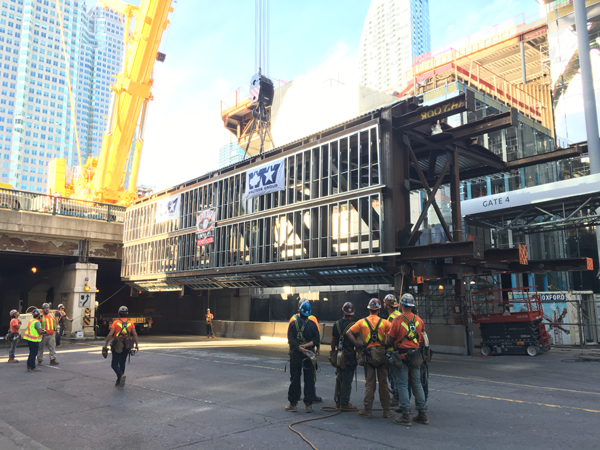
After years of planning, the project’s groundbreaking was held in June 2017. Since then, even with constant communication and coordination with every possible organization involved, challenges have still happened – even when they’re foreseen well in advance.
A frequent challenge is difficulty in stopping traffic to accommodate construction. The increase in road and pedestrian traffic from one of Canada’s most popular entertainment venues immediately next door is also an ongoing challenge as construction finishes up.
“Every time you do one step forward, you do two steps backward, trying to please everyone,” says Boulanger. “Every change affects everyone, so we need to discuss them constantly with the city, neighbours, crews, architects and tenants.”
Challenge Highlight: Rail Corridor Overbuild
Spanning 16 rail tracks and connecting the towers will be a one-acre park – a concept that has never been done to this scale before in Toronto.
“There’s no way the overbuild could have been built with anything except steel,” says Frank. “If any column is taken out, the overbuild will still stay up. Enormous steel cantilevers will even be installed to support a restaurant.”
“We looked at concrete and precast construction, but for the construction logistics and the economics and space, steel was really the only option,” adds Voth. “In one evening, Walters’ crew swung into place a 45.5-metre long-span truss, the weight of 53 mid-sized cars, over the corridor tracks. There was a very short window to stop all train traffic, and they did it perfectly.”
Any time work along the tracks was required, a work plan needs to be submitted, reviewed and approved for every single operation along the long spans. “Sometimes Walters only had four hours a night to work,” says Boulanger. “And other times there would be a full work crew ready to go, then a train would be delayed, so the entire evening would be cancelled.”
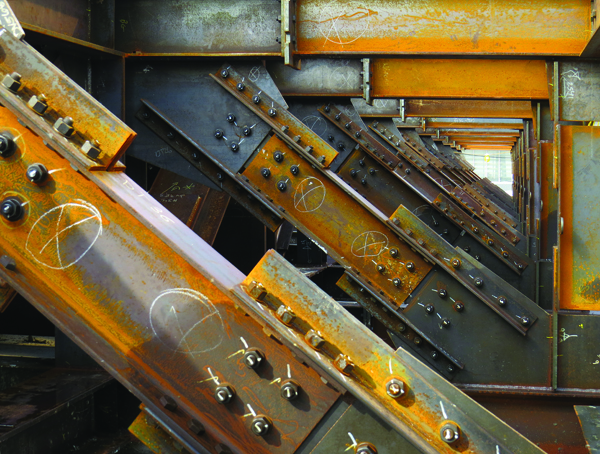 Challenge Highlight: The Scotiabank Arena Bridge
Challenge Highlight: The Scotiabank Arena Bridge
The 36-metre bridge is unlike any other, with a glass wall on the south side, spanning across Bay Street to the arena.
“The Scotiabank Arena bridge has a very challenging structural system to accommodate a full height glass wall overlooking Lake Ontario.” says Tim Verhey, Executive Vice President, Engineering & Operations, Walters Group. “Our crews preassembled it at the Cherry Street docks, and delivered it to the site in two sections.” The bridge was installed over Labour Day weekend last year, one of the few occasions that this section of Bay Street could be shut down with minimal disruption.
The Next Generation of Tower Construction
In addition to the stunning steel structures that require years of planning and unparalleled communication and logistics, CIBC SQUARE also represents the leading edge of technology and environmental innovation.
“This is a next-generation building,” says John Frank. “It’s the most technologically advanced project I’ve ever worked on, and I’ve been with Hines for 35 years. It’s certainly the best office building in Canada. Maybe even North America.”
Highlights include:
- Engineered to LEED® Platinum standards (Walters’ fourth LEED® certified office tower)
- Pursuing WELL Building Standard™ Building certification
- First building in Toronto to have earned Wired® Platinum Certification for best-in-class technology infrastructure
- Energy costs will be reduced by 40% as outlined by the National Energy Code of Canada for Buildings
- Tenants will receive feedback on their energy consumption
- Each tower will include 500+ bicycle storage racks and tenant-shower facilities
A Building of Successful Stories
This project will have a positive, lasting impact on Toronto, and will change the way commuters and residents enjoy downtown.
“This has been a very challenging, complex project for all involved. It truly has been an honour to be a part of the team and work amongst some of the most respected and talented individuals within the industry,” shared Verhey. “It will stand out for all of those who worked on the project, as well as amongst Toronto’s skyline, for many years to come.”
“Once both towers have been completed, CIBC SQUARE will be one of the most iconic landmarks in the City of Toronto,” concludes Quadrini.
STEEL FACTS:
15,360 tonnes of structural steel are being used
The heaviest truss on the overbuild is 45.5 metres long, 4 metres deep and weighs 85,000 kilograms
The pedestrian bridge connecting the tower to Scotiabank Arena is just over 36 metres long and weighs 210,000 kilograms
The Bay Street canopy is 69 metres long, 14 metres wide and stands 25 metres above ground level
If you stacked all 100 trusses from the rail corridor overbuild end-to-end, they would be 2.5 times the height of the CN Tower
There are 208,000 bolts being used. If you laid them out end-to-end, they would stretch as long as the Gardiner Expressway

